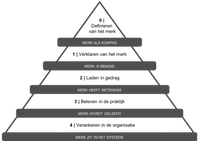Internal Branding Phasemodel©
Based on years of Internal Branding experience, the phase model has been developed, the Internal Branding Phase Model©. This model works well in practice because it is built on insights into how to bring people into development. The phases are designed in a way that maximizes the likelihood of people participating.
Bringing a brand to life and anchoring it in an organization involves four phases: declare, charge, experience, and anchor.
From the book: 'The Success of Internal Branding' by Marc van Eck, Ellen Leenhouts, and Linda Rutten
Declaring the brand
Once the brand is determined, the first phase of Internal Branding is to explain to the organization in a proper way why these choices have been made and why the organization deems it essential to truly realize them. If the message is delivered and explained well, employees often feel positively challenged and inspired.
Charging the brand
The brand is determined and declared, but it lacks energy. In the second phase, the charging phase, employees make the brand their own. Literally. They give it their own meaning: 'what does the brand mean for me in my work?' When employees do this with colleagues they work with daily, share images and meanings with each other, and convert them into concrete behavioral intentions, it strengthens the meaning of the brand.
Experiencing the brand
The brand only comes to life in people's work. While before it was mainly about words, now the focus is on the experience. Living the brand, doing it. As people start to incorporate the brand into their daily activities, it comes to life. The brand becomes dynamic. It takes action. You can see it, people do it. 'Look, there he goes again, embodying the brand.' This can be in behavior or in the output of work. Both aspects can be trained for individuals and teams.
Anchoring the brand
In the previous phase, people experience the ways in which you can use the brand in your work. If you persist in doing that long enough, it becomes a pattern, a habit. The brand is then figuratively 'embedded' in the organization's system. To assist this anchoring process, it is important to literally integrate the brand into systems. Management systems, work procedures, and HR instruments are scrutinized in light of the brand and adjusted where necessary. The work environment is adapted to the brand. Without the right set pieces and props, it is simply difficult to consistently and coherently bring the brand to life. But even business plans are consistently developed from and evaluated based on the brand. This way, the brand becomes an integral part of the business operations.
"Culture eats strategy for breakfast"
Peter Drucker
